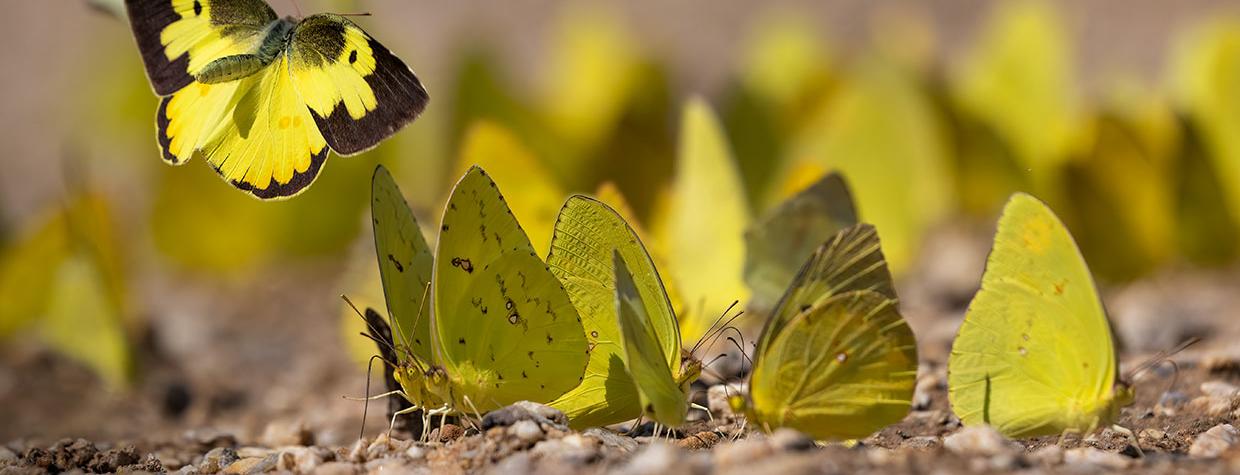If you were to choose a bug’s life, being a butterfly would definitely be the way to go. For one thing, there’s variety. You start off as a caterpillar — cute and even fuzzy, not creepy and slimy like maggots or other lesser insect larvae. You eat yourself silly for a week or two, fattening up with the dedication of a sumo wrestler in training, before molting into a chrysalis.
Then you hang out for a while: Inside the chrysalis, you basically melt, turning into a protein goo, and start reconjuring, part by part, transforming what remains of the old you into the new-and-improved you: a butterfly — the most beloved bug of all.
Let the ants toil for the colony’s greater good and the bees buzz and drone in service of the hive. You, you’re on your own, free to drink from the nectar of life, fluttering from blossom to blossom and dazzling the world with your brilliantly colored and elaborately patterned wings. Science fiction writer Robert A. Heinlein went so far as to say butterflies are not insects but “self-propelled flowers.”
I briefly consider sharing these musings during a spring hike into Sabino Canyon with Katy Prudic, a butterfly expert and assistant professor of citizen and data science at the University of Arizona in Tucson. She’s also co-founder and co-director of eButterfly, an online project designed to collect information and observations from participants around the world to better understand the impact of environmental change on butterflies.
Prudic has an easy manner, as well as a nice sense of whimsy. She’s accomplished enough to have earned an invitation to the White House to participate in a 2015 forum on citizen science, yet sufficiently cool that she has just returned from Austin, Texas, after delivering a presentation at the cultural fandango South by Southwest.
We set out for Sabino Lake, the small impoundment behind Sabino Creek Dam, and Prudic gives me a crash course in the intricacies of a butterfly’s existence. The insects are synonymous with spring, but late summer and early fall, particularly in years with good monsoons, is prime time to see Arizona’s approximately 315 butterfly species. (The two-tailed swallowtail is the state butterfly.)
Thanks mostly to Arizona’s range of landscapes and ecosystems, from low desert to alpine environments, the state’s tally of species is the country’s second highest, behind only much larger Texas. And more butterflies are expanding their ranges north into Arizona from Mexico as the climate warms.
“Arizona is one of the most diverse places in the U.S. for butterflies and other insects,” Prudic says. “And that has to do with the ‘sky islands’ that just pop up in the middle of these lower desert seas. Butterflies moved up those mountains at different points in their history, and their closest relatives might be a couple of hundred miles away, in another sky island. They haven’t seen each other for a while, so these species have diversified and are no longer the same.”
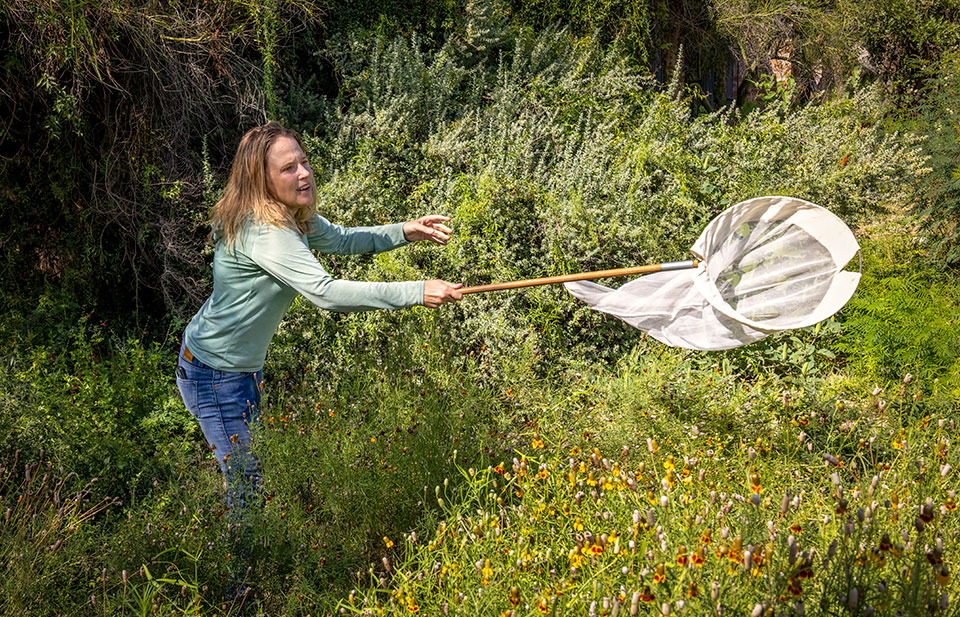
Prudic busily identifies the butterflies fluttering around us. A yellow-green cloudless sulphur alights on a shrub, and a mourning cloak, its wings edged in yellow and freckled with luminous blue spots, passes by before Prudic points out a couple of male pipevine swallowtails flitting around trees and searching for females.
Prudic’s butterfly life list has reached 380 species or so. When I ask her for a favorite, she briefly demurs, then mentions the regal fritillary, a denizen of tallgrass prairies; it’s orange and black with silver spotting and a purplish sheen on its upper surface. “It’s exceptionally ornate,” she says. “Some would say gaudy. But I call it beautiful. Butterflies are supposed to be a little over the top.”
We settle in on a boulder — not an especially comfortable boulder, but one within earshot of the trickling creek and overlooking the shallow lake, which perfectly reflects a cottonwood and a multi-trunked willow. Prudic chose the lake for a very good reason: Despite all the nectar they consume, butterflies need water, making small ponds and riparian areas big draws, especially in the desert.
“For insects, it’s really about the disruption of their osmoregulation — whether or not they’re hydrated, basically,” Prudic says. “Hot, dry conditions aren’t great for insects. They’re small, they lose water very quickly, and once it’s lost, they just spiral down. Increasing aridity, which we already know is happening in the western U.S., is going to continue to be a problem for butterfly survivorship and their ability to make a living on the landscape.” Caterpillars, eggs and pupae are even more at risk, she adds, because unlike the adults, they can’t easily reach shadier, cooler microclimates.
I’m fascinated but also begin to wonder how someone metamorphizes into a butterfly expert, which isn’t a career path that’s typically mapped out at high school job fairs. Prudic grew up in Northern Nevada and hoped to become a marine biologist, so much so that she took French because she thought one day she would meet Jacques Cousteau. “The logic of a 13-year-old,” she explains. She was especially interested in deep-water marine biology, but during her first class at New England’s Shoals Marine Laboratory, she discovered an occupational hazard: She got horribly seasick.
Thus ended the life aquatic, and Prudic transferred from American River Junior College to the University of California-Davis, where one day a friend led her to a professor’s office, describing it as a campus landmark. The office belonged to ecology and evolution professor Arthur Shapiro, a world-renowned butterfly authority, and his door was covered in newspaper clippings on subjects ranging from pop culture to the latest scientific studies.
“Art was in there somewhere, but behind many, many stacks of papers,” Prudic recalls. “There was a small path through his office, but it was mostly just papers and books. You would be talking to him and he would say, ‘Oh, I’ll get you that paper.’ Then he’d walk six stacks over and three-quarters of the way down, find and pull out the exact paper he needed.”
Prudic soon learned Shapiro was hiring a field assistant and thought, You’re going to pay me to catch butterflies? Yeah, I’m in.
Butterflies offered a number of advantages — for one, no ocean swells. And unlike many other animals, which require nocturnal surveillance or predawn stakeouts in freezing conditions, butterflies are eminently civilized creatures, late risers who take flight midmorning on sunny days with moderate temperatures.
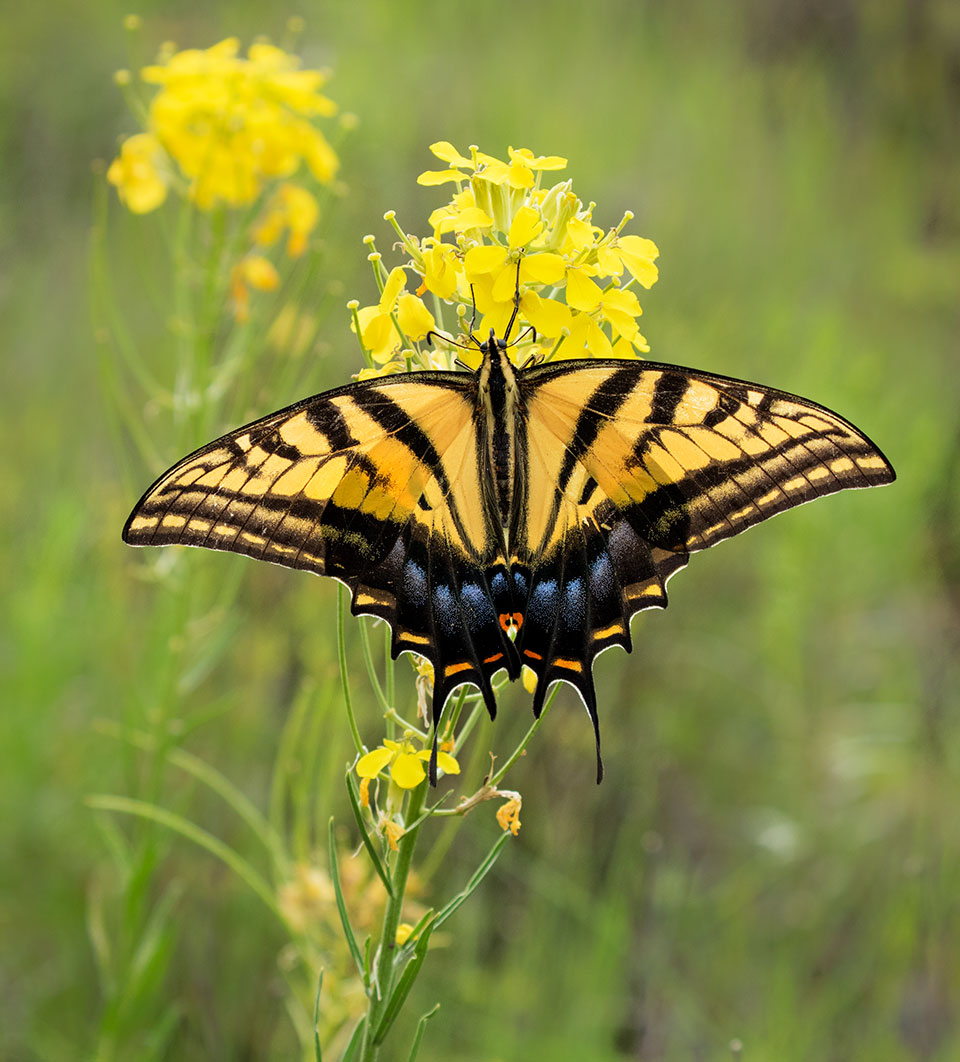
Whatever works. Moths and butterflies have survived for roughly 200 million years — beating us Homo sapiens by a mere 199.5 million years or so — and are extremely successful, diverse organisms. They’ve made it through a couple of mass extinction events, and there now are about 19,000 species of butterflies and moths.
Butterflies see in ultraviolet wavelengths and discern far more colors than humans, an essential asset when your well-being depends on flowers. They smell with antennae and taste with legs, and their wings are masterpieces of evolutionary design. Microscopic scales fit together like roof tiles, and an intricate system of ribs and perforations reflects and absorbs light, giving the wings their celebrated colors and patterns.
But Prudic says butterflies are facing a combination of intensifying threats during “a time of rapid change.” There’s the climate crisis. Insecticides intended to kill bad bugs also kill good bugs. And both residential development and monocultural farming practices have destroyed stands of native plants on which the butterflies depend for food and to nurture caterpillars.
“People who study animals and plants right now are having a hard time, realizing that a lot of things that they know and like and have spent so much time with are in so much trouble,” Prudic says. “There is an emotional hardship knowing that this is what’s happening to, in some ways, a dear friend. I mean, you’re fine. But I like butterflies more than I like some people.”
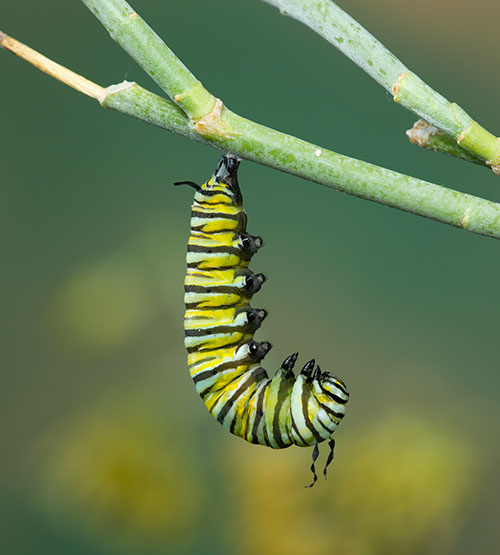
and beginning to form a chrysalis (middle) to emerging as a butterfly (bottom). | Bruce D. Taubert
When it comes to butterflies, monarchs were my gateway bug. At day camp outside Chicago, we found patches of milkweed where chubby monarch caterpillars, striped with bands of yellow, black and white, gorged themselves. A few ended up in empty juice cartons and, along with a milkweed buffet, rode home with us on the bus. That was when things got interesting.
One caterpillar soon attached itself to the top of an aquarium and transformed into a chrysalis, then, maybe 10 days later, emerged as a butterfly. Releasing the monarch in my backyard was like the culmination of a science fair project and proof positive to an incoming fourth-grader that miracles do happen.
A butterfly’s metamorphosis is certainly mind-blowing. Inside the chrysalis, the caterpillar uses enzymes to dissolve its organs. A few sacs of cells, known as imaginal discs, survive to form such butterfly parts as the head, wings, legs and eyes. “It’s a messy transition,” Prudic says. “You’re essentially digesting everything down and rebuilding. I mean, you thought your puberty was bad? I look at a butterfly and go: ‘Yeah. Respect.’ ”
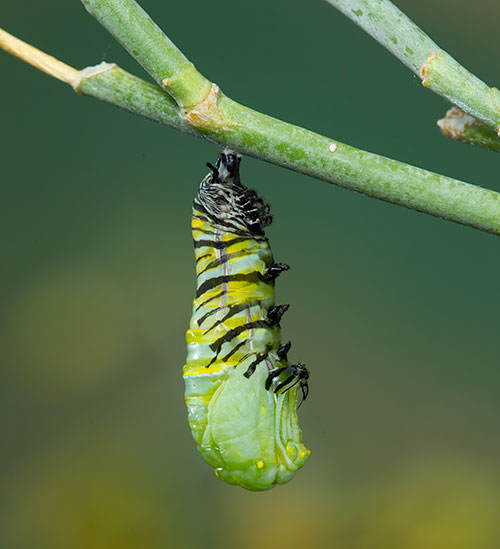
Back then, monarchs were pretty common — just another part of summer. It’s been shocking, then, to hear about their steep decline during the past 40 years, estimated at 80 percent among the eastern North American population and 99 percent in the West. A plunge in pollinators can be a leading indicator of looming environmental problems, meaning that as canaries in the coal mine go, monarchs might be the elephants in the room.
“What I’m most concerned about is not necessarily many butterfly species going extinct but that they provide a lot of what we call ‘ecosystem services,’ ” Prudic says. “Butterflies do pollination, and one of the important things we forget is that they also move carbon across the trophic levels. Basically, they’re good snacks. Caterpillars eat plants, then are eaten by many vertebrates — your rodents, your bats. I often refer to caterpillars as eggs with legs. They’re juicy and nutritious.”
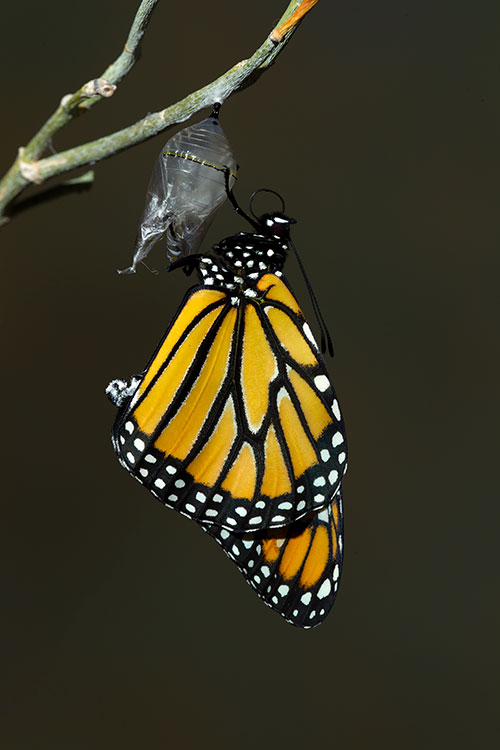
Arizona is on the front lines for North America’s monarchs because, unlike in most states, they have three different directions to migrate. Some head to the California coast, others fly to Mexico’s Sierra Madre, and still others don’t migrate at all, instead remaining in the Sonoran Desert.
With 30 different species, Arizona has the second-greatest diversity of milkweed in the country, once again behind Texas. Milkweed is critical, both for caterpillar nutrition and because it contains heart toxins called cardiac glycosides. Monarch caterpillars have adapted to the glycosides, giving them near-exclusive access to milkweed as a food source, and the toxins make monarchs poisonous to potential predators at all life stages. Adult monarchs’ brilliant coloration sends a warning that the butterflies won’t make for very good eating.
So, no milkweed, no monarchs. But unlike larger animals, butterflies don’t necessarily require thousands of contiguous acres to be set aside as habitat. A more piecemeal approach, in which scattered patches of milkweed create a network of way stations where butterflies can feed and lay eggs, can supplement larger areas. Even sidewalk medians and highway roadsides are potential habitat. Prudic says there has been increased coordination with agencies such as the Arizona Department of Transportation to plant flowers and limit mowing and maintenance to times when it will have the least impact on pollinators.
And when it comes to butterflies, you can’t downplay the potential contributions of local heroes. Organizations and institutions, including the Southwest Monarch Study and Phoenix’s Desert Botanical Garden, are encouraging homeowners to create backyard habitats by planting shelter trees and flowers that bloom at advantageous times for butterflies, as well as native milkweeds, which are increasingly available at Arizona nurseries.
Citizen science efforts, both field operations and tagging programs that can track individual butterflies, have helped the professionals amass scads of additional monarch data. More boots on the ground means more eyes on the skies, and Southwest Monarch Study coordinator Gail Morris says that there have been encouraging increases in recent monarch numbers.
A newly released University of Georgia study also concluded that nationwide monarch numbers actually remained stable over the last 25 years, although Prudic says the data is inconclusive because the research focused on summer generations.
“The analysis they did has validity, but the data may not be sufficient to capture the decline,” she says. “Unlike the winter generation in Mexico and California, where we are seeing declines, it’s harder to see the summer declines. In summer, monarchs are more dispersed on the landscape, there are overlapping generations, and most of the death and destruction isn’t happening until they travel south. Migration is tough.”
Underscoring the precarious situation for monarchs, in July, the International Union for Conservation of Nature listed these butterflies as an endangered species.
A few weeks after my hike with Prudic, Morris and I talk butterflies — both the latest science and, less tangibly, why the average person should bother turning over a portion of their backyard to the insects.
Morris thinks it over, then replies, “It’s not just for the monarchs. Because you’ll also get to see the monarchs, and other butterflies, and the hummingbirds that will start coming through your backyard. It’s helpful to step out and enjoy what we’re seeing, and it offers us the chance to calm down in a world that can be divisive and difficult to live in. We can get away from that and be healed. We’re helping other creatures, but we’re also helping ourselves.”

